Made In Santa Barbara, 2006
What Happens in Santa Barbara, Did Not Stay Here:
Local Ideas Everyone Enjoys
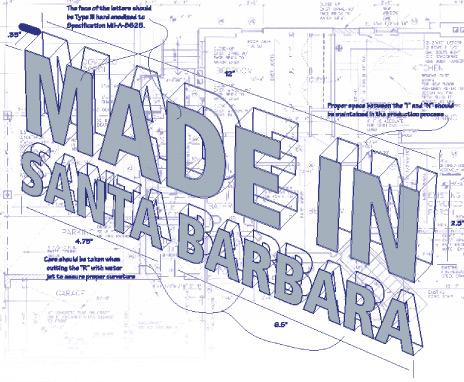
For this year’s Made In issue, we’ve decided to do something a bit
different than previous years. Since it’s our 20th anniversary, we
thought we’d find out what — if anything — our little hamlet had
created that has broken through the county boundary and become
nationally recognized. It was surprisingly easy to come up with 20
fabulous things. For example, did you know that Motel 6 was started
in S.B.? And Hidden Valley Ranch dressing, Earth Day, and the Egg
McMuffin, for that matter? Read on to learn of the other now
commonly known national products that germinated here.
And for those who rely on this issue to help you with your
shopping, don’t despair. We have also included information about
the best places to buy unique gifts made by fellow Santa Barbarans,
and how to think outside the Christmas gift-buying box.
EARTH DAY

Thirty-eight years old this spring, the annual celebration of
Earth Day has its origins right here in Santa Barbara. Earth Day’s
founder, Wisconsin Senator Gaylord Nelson, was inspired not by the
region’s outstanding beauty, but by the 800 square miles of slick,
black crude oil that covered the Santa Barbara channel and coated
South Coast shorelines when he visited the area shortly after the
disastrous 1969 oil spill. Moved by the devastating environmental
impact of the spill and impressed by the spontaneous grassroots
response, Nelson returned to Washington, D.C., and passed a bill
designating April 22 as a nationwide teach-in day for environmental
issues. The following year, Santa Barbarans came out in full force
to celebrate the first Earth Day, along with 20 million other
Americans in thousands of cities and colleges who demonstrated
peacefully in favor of environmental reform. “The Santa Barbara
incident has frankly touched the conscience of the American
people,” said then-president Nixon, who spoke of the spill as a
wakeup call “for preserving the beauty and the natural resources
that are so important to any kind of society we want for the
future.”
Though the conservation and ecology movements predated Earth
Day, many credit the celebration with launching the environmental
movement. Within three years of Earth Day’s inauguration, the
Environmental Protection Agency was formed, and amendments to the
Clean Water and Clean Air acts had passed through Congress. The
Santa Barbara festival lost steam during the Reagan era, but
enjoyed a rebirth in 1990 with the Community Environmental
Council’s official adoption of the festivities, which drew 30,000
people to hear Jackson Browne and David Crosby. Today, Earth Day is
celebrated internationally; the United Nations rings the Japanese
Peace bell on the vernal equinox each year in honor of the
festival.
— Elizabeth Schwyzer
BALANCE BAR
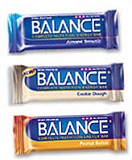
People come to Santa Barbara agog with heady visions of
panoramic hikes, sculpted surf, and chiseled crags; you hike, you
surf, you climb — you need protein! Luckily for you, Santa Barbara
is the original home of Balance Bar, one of the world’s premier
energy bar makers. Established in 1992, not long after
Berkeley-based PowerBar, Balance Bar was the brainchild of a team
of entrepreneurial outdoor enthusiasts who wanted to do two things:
create a tasty, protein-rich candy bar that was actually good for
you, and make mounds of money doing it. At both they succeeded.
Using the popular energy-bar nutritional template of 40 percent
carbohydrates, 30 percent protein, and 30 percent fat, the Balance
Bar team constructed a chocolate fantasia of effervescent
effect — it boosted your energy and didn’t taste like the bottom of
your brother’s gym shoes. And, in so doing, they made the kind of
scrilla that would have caused Louis XIV to gasp in envy.
Unfortunately for those with scruples about consuming products
created by gigantic corporations built on the strength of tobacco
sales, Balance Bar was bought in 2000 by Kraft Foods, a subsidiary
of Philip Morris, the largest cigarette maker in the country.
Perhaps befitting such a grim turn of events, the company now makes
its home not on the sunny shores of the South Coast, but rather the
smoggy gray hinterland of New Jersey. Merde!
— Sam Kornell
POWELL CORPORATION
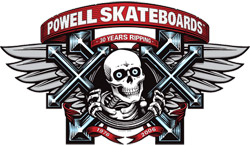
Few men have put a Stanford engineering degree to more creative
use than George Powell, founder of Powell Corporation, a
Goleta-based manufacturer of skateboards that are sold throughout
the world. While working as an aerospace sales engineer in the
early 1970s, Powell made skateboards in his free time,
experimenting with different materials for decks and baking
urethane wheels in his oven. Though these boards were initially
intended for his son, the Los Angeles native soon realized he had
developed a first-rate board that couldn’t be found anywhere else.
So in 1976, he moved to Santa Barbara to market his creation.
Powell’s name became well-known among skaters just one year later,
when he launched his unique wheel formulation under the brand Bones
Wheels, which has since come to dominate the industry. In addition
to Powell’s scientific contributions to the skate world, he was
also instrumental in popularizing the sport in the early 1980s,
when he teamed up with legendary skateboarder Stacy Peralta to
produce documentary films about skateboarding. And at a time when
very few skate parks existed, Powell Skate Zone — part of the
Goleta facility — served as a haven for amateur and professional
skaters alike.
Now, 30 years after Powell sold his first board, all Powell
original brands are still manufactured and tested in the factory on
La Patera Lane — and George Powell remains the mad scientist and
design genius behind it all. Unlike competitors who lower their
costs by relying on cheaper overseas materials and labor, Powell
Corporation leads the industry by using quality materials to
produce boards that are tested again and again onsite before being
shipped to stores.
— Hannah Tennant-Moore
SHORTBOARD

Not too long ago wave riders took to the sea atop massive
single-fin surfboards devoid of leashes or wet suits. The
standard-issue shortboard — with its lightweight design and
three-fin setup — that now clogs surf breaks was but a twinkle in
the eye of surfers during the sport’s early years. As recently as
1967, the average size of a board came in at 9ʹ6ʺ long, 22ʺ wide,
and weighed 26 pounds, with surfing styles reflecting the mass,
bulk, and scale of the boards being ridden: turns were slow and
infrequent, lines drawn across a wave face were gradual and soft,
and nose-riding was the penultimate display of skill. However, by
1970, surf equipment transformed to an average size of about 6ʹ6ʺ
long, 20ʺ across, and a weight of 10 pounds. With this came a
vastly different approach in wave-riding style — surfers could now
carve easily, race fast sections, slice in and out of the curl, and
get barreled more than ever before. High-performance surfing was
born.
While debate still exists, most surf historians trace the
creation of the shortboard to the design innovation and wave-riding
style of a certain “barefoot genius” from Montecito, George
Greenough. Honing his skills at Hammonds, Rincon, and various
haunts up Hollister Ranch way, Greenough’s homemade kneeboards,
narrow-base fin design, and unique style of surfing was the
stimulus for the shortboard revolution, inspiring Australian board
maker and surfer Bob McTavish to develop shorter boards for
stand-up surfers. With design shots being called by McTavish and
Greenough, world champion Nat Young introduced these new boards to
the world on the North Shore of Hawai‘i in December 1967 and the
results set the surfing world on fire. Within a matter of months,
the innovations of a born-and-raised 805 surfer had spread around
the globe and surfing would never be the same.
— Ethan Stewart
MOTEL 6
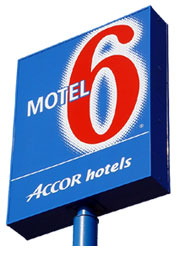
Though these days the chain promises to “leave the light on for
you,” it was in Santa Barbara where Motel 6’s light was actually
first switched on. In 1962, the first-ever Motel 6 opened a block
off Cabrillo Street, at the exact location where it still sits,
nearly 45 years later.
So why’d it catch on? Well, rooms were a mere $6 and less than a
city block from the beach (imagine that these days). Today, Motel 6
is the largest company-owned and -operated lodging chain in the
United States, according to Eric Studer, the senior VP of marketing
from Accor, the company that bought the Motel 6 business in 1990.
Currently, there are 869 Motel 6s in the United States and Canada
with more than 88,600 rooms for hire each night.
But the real reason that Motel 6, which has inspired plenty of
copycats throughout the years, is ingrained in the American fabric
is thanks to the advertising campaign of the last 20 years. That’s
how we’ve all come to know that on-air voice Tom Bodett will “leave
the light on” for us. And we’ve got Santa Barbara to thank for
making the lamp.
— Matt Kettmann
KIRBY MORGAN DIVE HELMETS
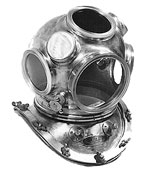
It is certainly true that Kirby Morgan diving helmets and face
masks are synonymous with quality worldwide, as their literature
states. However, it is also true that the long road from KMAH-1,
the company’s first heavy-metal gear helmet, to the popular new
Kirby Morgan-37 has not been entirely smooth. Bev Morgan founded
the company more than 40 years ago with Bob Kirby. Though Kirby
left some time during the 1980s, Morgan is still designing and
testing at his Santa Barbara “stinkworks,” while the helmets
themselves are manufactured in Santa Maria.
The partners made their first air-helmet in 1965 with two sheets
of copper and an important innovation: one-inch Plexiglas viewing
ports, instead of glass ports that had to be protected by
view-obscuring metal grills. Then they tried to get really fancy,
designing a series of fiberglass clamshell helmet prototypes, each
one leakier than the last until finally, as a joke, they came up
with the Bucket Hat. The Bucket Hat appears in the product
photograph to be made from an actual steel bucket such as might be
used to mop the floor or feed the horses, and, according to the
copy, “dives quite well and is surprisingly comfortable.” It is no
longer in production. The company also went through several name
changes — from Kirby Morgan Corporation to Deep Water Development
to Diving Systems International, and now full circle back to Kirby
Morgan Dive Systems. Call it what you want to, it still fearlessly
leads the pack with evermore sophisticated innovations in diving
helmet design.
— Martha Sadler
SEX WAX

Made in Carpinteria and invented in Goleta by Nate Skinner, Mr.
Zog’s Sex Wax dates from 1972, when Charles Frederick Herzog III
accepted his life’s mission to bring good wax to the sticks. What
began with Zog and Nate pouring Sex Wax into discarded tuna cans
and Zog driving up and down the coast of California with stacks in
the back of his car has now become a worldwide phenomenon. Sex Wax
comes in four varieties for surfing: Sex Wax, Quick Humps, Really
Tacky, and Navel Wax (a body-boarding wax). Sex Wax now also
manufactures snowboard waxes, and continues to be at the forefront
of the surf T-shirt business.
Santa Barbara landscape painter Hank Pitcher gets the credit for
the name and the logo, both of which reflect a timeless sense of
the absurd that nevertheless seems most at home in the “Have a Nice
Day!” decade of the 1970s. Sex Wax laid down that first sweet coat
of tacky irony on the gleaming fiberglass of modern board culture,
and in the process did a lot for surfing, Southern California, sex,
and, um, wax. The cultural climate has changed since the early days
of Zog’s empire, and his old newsletter, which was like a more
idiosyncratic version of The Onion, has given way to a great
sponsorship program that helps some of the hottest young surfers in
the area. Check out the full story of Sex Wax and video clips of
the Sex Wax team in action at sexwax.com.
— Charles Donelan
SANSUM DIABETES RESEARCH INSTITUTE
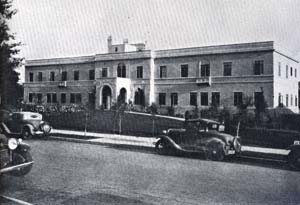
When a doctor tells someone he/she has diabetes, the doctor
can’t just hand over a prescription and strongly suggest the
patient take it. That patient has to adapt his/her entire lifestyle
to a system of vigilant self-care or risk a slew of nasty
complications. One-and-a-half million Americans confront this
nightmare annually, contracting either juvenile or adult-onset
diabetes (known respectively as Type 1 and Type 2). Seven percent
of the American population has it and 54 million have its
precursor — insulin resistance.
But Santa Barbara is proud to be part of the solution. The late
William Sansum, MD, founded Sansum Diabetes Research Institute
(SDRI) in 1944. By then he’d already made medical history, having
injected the first human being ever with insulin in 1922. It came
from the pancreases of animals at that time, crude by today’s
standards, but it did the trick: The 51-year-old patient who got
that famous shot lived to the ripe old age of 90.
SDRI is still a heavy hitter in the extremely competitive world
of diabetes research. It’s smaller than most research centers but
packs a wallop. Rochelle Rose, SDRI’s development director, said it
is the only organization in America testing implanted insulin
pumps. It’s also part of the prestigious Juvenile Diabetes Research
Foundation’s artificial pancreas project, working to develop
technologies in which glucose monitors and insulin pumps work
together in a closed loop system. As the monitor keeps tabs on
blood sugar levels and communicates to the pump how much insulin to
give the individual, it will mimic a real pancreas.
According to Matt Petersen of the American Diabetes Association,
Lois Jovanovic, MD, SDRI’s chief scientific officer, is considered
one of the most prominent clinical researchers in the field of
diabetes today.
Not bad for a home team.
— Isabelle T. Walker
TRI-TIP
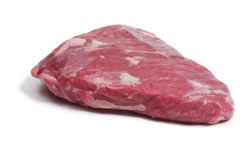
There is perhaps no more controversial county debate than where
tri-tip first originated. Santa Maria does all it can to lay claim
to the cut, but there’s plenty of evidence that it might have been
first marketed here in Santa Barbara sometime in the 1950s.
The debate is alive and well for such longtime butchers as Dave
Whitefoot from Whitefoot Meat Market & Deli and John Shalhoob
from Shalhoob Deli. But everyone in town bows to John’s dad Jerry
as the official voice on the history of meat in Santa Barbara.
According to Jerry, the ball-tip and the tri-tip were what was
left over after the wholesale meat choppers took away the more
desirable cuts. While the ball-tip was popular, the tri was usually
ground up or made into stew. But right around the time Jerry
remembers thinking that the tri-tip “was the most under-priced
piece of meat on the animal,” someone barbecued it and found
butchery gold.
“Throughout the years, it became more popular on the Central
Coast, then it moved to Southern California,” Jerry said, “and now
it’s popular throughout the state. I have a house on Maui and I’ve
even seen it over in Hawai‘i.” Due to the popularity, which extends
also to Washington and Texas, it’s now a more expensive piece of
meat. That’s supply and demand for ya, but there wouldn’t be any
tri-tip supply if it weren’t for our county’s butchers.
— Matt Kettmann
FORCE FIN
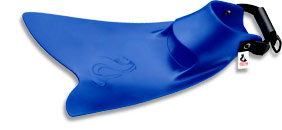
Santa Barbara, land of watery pursuits, by its very nature
invites innovation in all fields marine. Thus, we have Force Fin,
the internationally renowned dive fin-maker, which got its start
here and continues to occupy the same building it bought on Kimball
Street 10 years ago. Force Fin is the brainchild of Bob Evans, an
outdoorsy type who, as an underwater photographer in the 1970s, was
nonplussed by the state of diving fins. Instead of carping, he did
something; specifically, he started designing his own dive fins,
and was soon fielding requests from friends for personal pairs.
Evans started Force Fin 1985 and went international in 1990.
Today the company is widely recognized as one of — if not
the — premier fin manufacturers in the world. Among other products,
they produce top-quality fins for SCUBA diving, free diving, body
and boogie boarding, and even fly fishing. Evans’s efforts have not
gone un-lauded: This year he was the recipient of the most
prestigious award doled out by the Academy of Underwater Sciences.
And any plan to slow down is mute since Force Fin recently began
designing fins for Jean-Michel Cousteau, the famed underwater-man
and son of the even more famed underwater-man Jacques Cousteau.
Force Fin can be reached at 966-9628, or online at forcefin.com.
— Sam Kornell
SAMBO’S
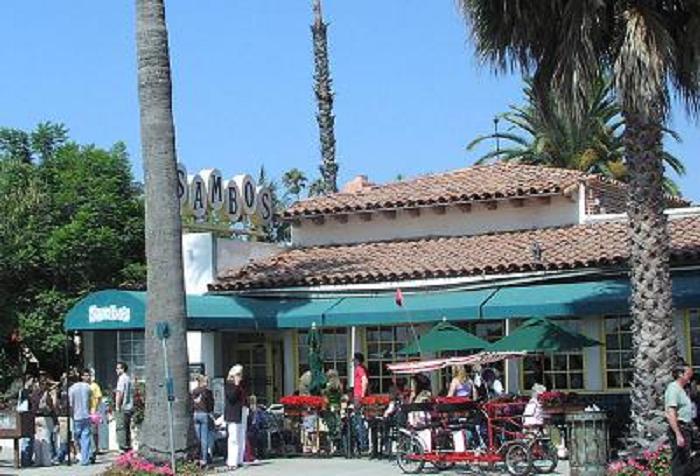
Snuck in among the posh hotels and fancy eateries on Cabrillo
Boulevard is the original — and only remaining — Sambo’s diner.
Each weekend, scads of hungry people mill around on the sidewalk
awaiting a table at which to eat pancakes and gaze out the windows
at the sand and sea.
Despite its idyllic location, Sambo’s has a rocky and
controversial history. Built in 1957, the restaurant’s moniker was
derived from the names of its founders Sam Battistone and Newell
Bohnett. Soon after its birth, however, Sambo’s became associated
with the 1899 book The Story of Little Black Sambo, by Scottish
writer Helen Bannerman, which told of a boy in India who outwits
hungry tigers. Although the U.S. version of the book had
illustrations that were re-interpreted in the demeaning “blackface”
iconography, Battistone and Bohnett capitalized on the mistaken
identity and decorated their establishments with images of the book
including a dark-skinned boy and tigers. Throughout the years,
however, the word “sambo” morphed into a racial slur against
African-Americans.
Although the diner had a good 20-year run — in 1979 it had 1,200
outlets in 47 states — by 1981 the company was bankrupt and being
sued by Dr. Pepper (for allegedly plagiarizing the soda pop’s TV
ad) and by non-white employees and applicants who claimed
discrimination in the diner’s hiring and advancement. By the end of
1982 all Sambo’s had closed their doors except for the one on
Cabrillo Boulevard.
— Michelle Drown
BIG DOGS

It all started with a group of friends, a river-rafting trip, a
set of colorful, oversized shorts, and the phrase, “Man, these
puppies are big!” That’s how Big Dogs, the sportswear brand with
that familiar canine logo, was born — and right here in Santa
Barbara. In fact, the brand’s first store opened on State Street in
October 1984. Now, more than two decades later, Big Dogs has retail
outlets in more than 150 locations, spreading its
California-inspired style across the country.
But the company’s roots are still firmly grounded in the 805.
Not only are corporate headquarters and a retail store — complete
with its famous graphic T-shirt wall — still here, but Santa
Barbara is also ground zero for the Big Dog Parade, the largest dog
event in the country. It started as a simple block party between
Big Dogs employees and some friends, and has grown into a spectacle
capable of shutting down the entire city for an entire weekend.
For 12 years, Big Dogs has been attracting more than 1,200
canines and 16,000 humans to downtown Santa Barbara for contests,
revelry, and good old-fashioned parade fun.
And in case you think the parade is just a clever marketing ploy
to advertise the company’s parody T-shirts and multi-generational
active wear, keep in mind that 100 percent of the proceeds from the
parade go to the Big Dog Foundation, a nonprofit charity benefiting
dogs, children, and dogs that help people.
— Molly Freedenberg
KINKO’S

The most successful business ever to come out of Isla Vista,
Kinko’s represents the fiscal fruition of a maverick entrepreneur’s
lifelong faith in the earning power of meeting ordinary people’s
desperate needs 24 hours a day. Kinko’s founder Paul Orfalea’s
extraordinary story is now well-known thanks to his recent
best-selling autobiography, Copy This! Orfalea struggled with
dyslexia all the way through his undergraduate career at USC, but
came into his own when he opened his first copy shop on Pardall
Road in the fall of 1970 with just one Xerox machine. Thirty-six
years later, the price of a single black-and-white copy at Kinko’s
has risen 100 percent, from 4 cents in 1970 to 8 cents in 2006 (or
9 cents if you are in what Kinko’s calls the “metro zone”). Not bad
if you think about it, especially in relation to say, the increased
price of Santa Barbara real estate during the same period.
Orfalea left Kinko’s in 2000 after a struggle with some new
part-owners — the investment firm Clayton, Dubilier & Rice,
Inc. While the new management team may have botched aspects of
Kinko’s initial public offering, the long-term fortunes of the
company have been truly astounding, with their acquisition by
Federal Express in 2004 yielding a price of $2.4 billion. For a
company that began by selling 4-cent photocopies to hippies in
I.V., that’s a long way, baby.
— Charles Donelan
TAILDEVIL
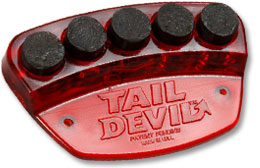
The X Games — the Olympics for extreme sports — coupled with the
mainstream success of the films Dogtown and Z-Boys and Lords of
Dogtown in recent years, have helped to commercialize the sport of
skateboarding. And skateboarding’s burgeoning popularity has given
birth to a huge market for skate fashion and accessories. But it’s
not just about stickers, wheels, and hoodies anymore — Santa
Barbaran Scott Starr has invented a lightweight plastic doohickey
that skaters attach to the nose and/or tail of their board, and
when the device makes contact with anything, sparks
fly — literally. Starr has dubbed his creation the TailDevil.
Since Starr introduced the TailDevil to the market two years
ago, it has sold like crazy, “without any real marketing at all,”
Starr claimed. The TailDevil’s popularity is likely due in large
part to the fact that it sticks discreetly to the bottom of any
skateboard deck, and it is very affordable.
Another reason the TailDevil has been so successful is Starr’s
familiarity with the world of skateboarding. The longtime Santa
Barbaran has lived and breathed the sport for the better part of
his life. Starr was Thrasher magazine’s main man behind the camera
in the 1980s when the skateboarding rag was just hitting the
shelves. He photographed the last three surf/skate posters for the
Santa Barbara International Film Festival, and he even shot the
cover image of this newspaper’s feature on skateboarding in
1999.
At $7.95, the TailDevil — which comes in black and red — makes a
perfect stocking-stuffer for the skateboarder in your family. Find
out more about the spark-tastic skate accessory at taildevil.com.
— Josh Brayer
ROBOTIC ARM
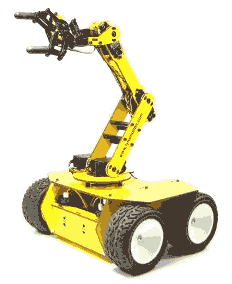
Often there are competing claims as to who actually invented
something. Take the light bulb, for example. Who invented it?
Thomas Edison? Joseph Swan? Alexander Nikolayavich Lodygin? A
strong case can be made for each of them. The same is true of the
robotic arm; Yulan Wang is an inventor — if not the only
inventor — of the arm-sized robots now commonly used in surgery.
Emerging from UCSB’s robotics research institute in the 1980s, Wang
formed a company called Computer Motion, which three years ago
merged with its chief rival for the patent on the surgical arm,
Huntington Beach-based Intuitive Surgical. Wang did not merge with
the company. Instead, he took two of the electrical engineers from
his original team and went on to found a new Santa Barbara company,
InTouch Health. The company is now making five-foot-tall
self-propelled robots reminiscent of the lines of Star Wars’ R2D2,
only these ones are called RP-7 and their function is to roll
around the hospital visiting patients and taking their readings.
RP-7 robotically reads charts, looks at and listens to the patient,
and can display the physician’s face in real time. The helpful
robot is already making itself useful in more than a dozen
hospitals, though not yet in this county.
— Martha Sadler
RADON BOATS
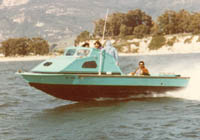
Crossing the Santa Barbara Channel is no easy business. Still,
every day, in the name of adventure or business or both, fishers,
scuba divers, and surfers leave the safety of S.B. Harbor for the
unpredictable waters of the channel. It is the treacherous nature
of this crossing that gave birth to some of the most trustworthy,
functional, and distinctive custom fiberglass skiffs the world has
known. Currently celebrating its 40th anniversary, Radon Boats was
born during the golden age of Santa Barbara’s commercial abalone
and sea urchin industry, its trademark spoon-billed hull design and
high-speed planning capabilities forged in the harsh north winds
and wicked seas of the channel.
The story of Radon begins in the early 1960s, when a
construction worker from Washington named Ron Radon Sr. relocated
his family to Santa Barbara. Shortly thereafter, Radon began a
career in abalone diving and thusly required a boat. After working
a few seasons on various boats and looking to remedy the
shortcomings of his previous boats, he set about designing his own.
With the help of his three sons, Don, Mike, and Ron Jr., the elder
Radon built a custom 24-foot diving/fishing boat that was unlike
any other being made at that time. His vessel became the talk of
the harbor and the envy of many a channel crosser. People started
offering to buy his boats and hence the custom boat company was
born.
Though it has gone through a series of splits, mergers,
international franchise efforts, and changes of ownership
throughout the years, the distinctive Radon hull design and
unparalleled open ocean stability are now once again being custom
built in the 805 for customers the world over by Don Radon in a
boatyard on Depot Road in Goleta.
— Ethan Stewart
HIDDEN VALLEY RANCH DRESSING
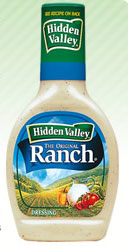
Make a salad with the healthiest greens and veggies you can
find. Now, if you’re like the majority of Americans, you’ll opt to
drown it in the cool, creamy flavor of ranch dressing. The
topping — which doubles as a dipping sauce for all manner of finger
food — has been the most popular in the United States since 1992,
according to the Association for Dressings and Sauces. It’s hard to
even picture a salad bar without a small reservoir of ranch at the
end of it, but the dressing did not exist until 1954, when Steve
and Gayle Henson bought a plot of land in rural Santa Barbara
County and named it the Hidden Valley Ranch.
A hotspot for students, travelers, and company picnics, Hidden Valley Ranch
quickly became known for its salad dressing, which Steve Henson had
created while working as a plumbing contractor in Alaska. The
mixture of buttermilk, mayonnaise, and herbs made greens more
palatable for his workers, so he figured it would taste just as
good to those in sunnier climates.
It did, and soon demand for Hidden Valley Ranch Dressing had the Hensons realizing their
marketing opportunity. As the story goes, Henson approached Cold
Spring Tavern owner Audrey Ovington with his concoction, which she
tasted, loved, and promptly added to the menu, making the
restaurant the first to serve ranch dressing. Soon, markets and
eateries throughout Santa Barbara were clamoring for this
alternative to vinegar-based dressings. Today, a slightly modified,
non-refrigerated version of Henson’s recipe is sold in stores by
the Clorox Company, which purchased the brand for $8 million in
1973. Ranch, now also common as a potato chip flavor and as a pizza
condiment, has become an American mainstay.
— Drew Mackie
SEYMOUR DUNCAN GUITAR PICKUPS
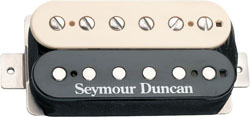
Ask any average music fan about Seymour Duncan guitar pickups
and they may shrug and mutter, “Seymour who?” But even average
music fans — those who need their daily dose but aren’t obsessive
about the details or the background technology — have been directly
and indirectly influenced by the work done out at the Goleta plant,
where Seymour Duncan and company are based.
Duncan is a New Jersey-born and longtime Santa Barbara-based
guitar player and inventor who befriended Les Paul and Roy Buchanan
early on, and whose own obsession with how things work led him to
create coveted, customized electric guitar pickups. Countless
important musicians have relied on Duncan pickups and he has
officially left his mark on the sonic landscape of popular
music — just below the surface, but very much in the DNA of the
music we hear. When legendary guitarists like Jeff Beck (Duncan has
worked on Beck’s pickups since his earliest albums) and Steve
Miller pass through town, they stop to pay respects, onstage and
off.
In business for 30 years now, going back to a humble shop on the
Eastside, Duncan’s reputation grew quickly — with the logistical
help of business partner and ex-wife Cathy Duncan — and they
expanded into the current large HQ in Goleta. Every year at the
sprawling NAMM show in Anaheim Convention Center, the Seymour
Duncan booth is a magnet for aspiring and established musicians,
soaking up the latest from a company that has also expanded into
amplifiers and a new specialty in acoustic guitar pickup systems.
The research and development continues, and the sonic fruits are
coming soon to a radio or iPod near you. Visit seymourduncan.com.
— Josef Woodard
DECKERS
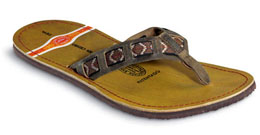
Unless you’ve been living under a rock, you’re likely familiar
with UGG Boots, Teva Sandals, and Simple Shoes. But did you know
they’re produced and distributed by a local company? In 1973, UCSB
student Doug Otto began making sandals, which he marketed under the
name Deckers. Since then, Deckers Outdoor Corporation has grown
into an international, publicly traded company. The original
Deckers sandals were manufactured for more than 20 years, but in
1985, when the company landed a license to produce and distribute
Teva sandals — originally designed for river rafting by Grand
Canyon river guide Mark Thatcher — Deckers was launched on a
tremendous growth trajectory.
In 1992, Deckers was awarded Company of the Year by Footwear
News; in 1993, Deckers acquired Simple Shoes, created by Eric Meyer
as a link between athletic and outdoor shoes. That same year,
Deckers completed its IPO, trading on the NASDAQ under the ticker
symbol “DECK.” Two years later, Deckers acquired UGG Holdings,
Inc., founded by Brian Smith in order to import sheepskin boots
from Australia to the U.S. and made wildly popular by People
magazine mainstays like Paris Hilton and Pamela Anderson. In 2002,
Deckers acquired the worldwide Teva patents, trademarks, and
assets, and now has complete ownership of all-things Teva. The
common thread between the three lines is how well they’re suited
for Santa Barbara’s distinctively casual, outdoor-loving lifestyle:
Emphasizing function, comfort, and technical performance, they’re
perfect for the mountains, the beach, and everything in
between.
— Shannon Kelley Gould
EGG McMUFFIN
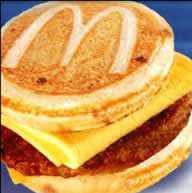
Sometimes the best stories don’t turn out to be true. For
instance, there’s a legend that Herb Peterson, owner of the South
Coast McDonald’s restaurants, invented the Egg McMuffin because he
found himself hungry one morning before his eateries opened. “Not
true,” Peterson told me when I found him lunching at his favorite
spot, the Santa Barbara Club. But it is true that Peterson came up
with the novel finger food right here in Santa Barbara. Not only
did the fast-food world rush to snap up Egg McMuffin, but it
transformed a burger chain into a place to go for a fast, tasty
breakfast, too.
According to the book McDonald’s: Behind the Arches, Peterson
wanted to launch “an entirely new food line.” By Christmas 1971,
according to the book, “Peterson had been working on the product
for months.” By using Teflon-coated metal rings, he could grill
eggs in a rounded shape to go on a muffin, topped with Canadian
bacon. McDonald’s owner Ray Kroc happened to be celebrating the
holidays at his Santa Ynez Valley ranch, and Peterson invited him
to stop by the store and taste the new creation. Kroc had just
finished lunch but devoured two of the egg-bacon-muffin sandwiches.
They were a hit. “At Kroc’s request, Peterson two weeks later
packed the Teflon rings in a briefcase and flew to Chicago to
prepare his new breakfast for the rest of McDonald’s senior
managers, all of whom responded as positively as Kroc had,” the
book reads. The rest is history, Santa Barbara-style.
— Barney Brantingham



